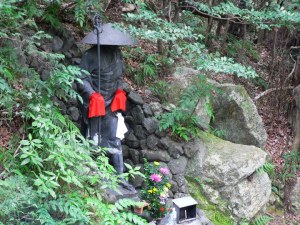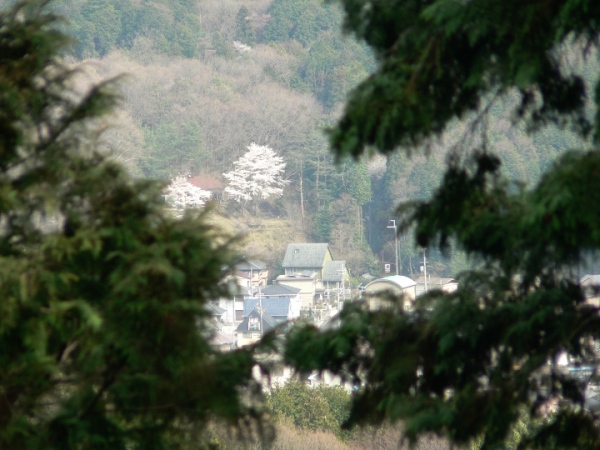To see what was on the other side…
It’s amazing how quickly later turns into now. Back from Japan for over a month now and I still haven’t posted pictures from the best parts. Early April brought visits from my Mother, my Aunts Donna and Maredith, along with our good friends Art and Margo. I think everybody had a good time as possible with us rushing them around for a week trying to get them everywhere but Bedlam. I was excited to have them in town and present for Motoko’s and my second wedding. (Don’t ask what we are going to do for our second anniversary, that’s just too much pressure right now.) The ceremony was on the 9th and following that was the Sanno-sai festival. Oh so many pictures and words so little time. I’m impatient and want to get these photos posted so I can start in on Whats Happening Now and praise Ralph. So lets get past these pop culture reference jokes that are too esoteric and hop into it. The day before my mom and aunts arrived into town I traveled with Motoko, my sister-in-law, and mother-in-law to a temple a stones through away from where (supposedly the first novel ever) The Tale of Genji was written. The temple is on the side of a winding river/mountain road and we had to climb 700 steps to get to the top. We alternated running and walking up and by the time we reached the bottom again our legs were shaking. Just in time to prepare us for touring around the next week. The temple is along the Setagawa River, Tachiki Kannon (Tachiki-san Anyo-ji Temple) is widely worshipped as a protector from evil. According to legend, Kobo Daishi (posthumously called Kukai), built this temple in the early Heian period at the “critical age” of 42. His statue was at the base of the stairs.
Looking back on this, (and double checking my facts before I post things) it was an interesting choice for Motoko’s mom to take us here. Kūkai made a trip to China in his twenties and had expected to spend 20 years studying there, but within a few short months he was to receive the final initiation, and become a master of the esoteric lineage. When he returned from China Emperor Heizei exhibited no great enthusiasm for Buddhism and Kukai was eclipsed by Saichō, the founder of the Tendai school. Saichō requested, in 812, that Kūkai give him the introductory initiation, which Kūkai agreed to do. He also granted a second-level initiation upon Saichō, but refused to bestow the final initiation (which would have qualified Saichō as a master of esoteric Buddhism) because Saichō had not completed the required studies, leading to a falling out between the two that was not resolved. Just a note before I rearrange more sentences from wikipedia: Tendai Buddhism was formed in Motoko’s neighborhood. Emperor Heizei became ill in 809 and retired the throne to Emperor Saga (who was supposed to be the first Japanese Emperor to drink tea). Shortly after taking the throne Saga became ill and Heizei formed a rebellion, which had to be put down by force. Kūkai petitioned the Emperor to allow him to carry out certain esoteric rituals which were said to “enable a king to vanquish the seven calamities, to maintain the four seasons in harmony, to protect the nation and family, and to give comfort to himself and others”. The petition was granted and Kukai became one of the most influential monks in his lifetime. Motoko’s mother went to college to learn the art of tea ceremony. To me this was all saying, “Yes, our neighborhood is interesting and there is a lot of history in it but it spreads out to bigger things. How are things connected? There is always something larger. Find more patterns.” Eh, and maybe she just wanted us to get some exercise with those steps. Somewhere close to the top (I wasn’t patient enough to continue counting the stairs after 213) I found a break in the trees.
As we approached the top I could smell incense wafting down the zig-zagging stairs. I raced my sister-in-law up the last couple of flights and bounded to the top surprising a man who looked like he was straight out of a 1980’s Yakuza film. He sported a stone-cold Elvis pompadour, an acid-washed blue-jean jogging suit (you read correctly) unzipped at the top with a gold medallion. It looked like he had just reached the top as well as he was a little sweaty and had just lit a cigarette. The three of us exchanged looks. My sister-in-law and I and then him at the two of us looking back at him. We paused a little too long and he puffed his cigarette. Motoko and her mom came up behind us and we headed towards a fountain to cleanse ourselves by washing our hands. The visitors part of the complex was smaller than most I had been to but the walk/run up the stairs made things seem large. There is a small banzai garden to the right along with a station that provides visitors with an extremely tasty lemon-grass tea. There is another statue at the top that I believe is Kukai ridding a deer. If i remember correctly folk-lore has it that when the level of the Seta river was very high, a white deer appeared and carried Kukai on its back across the river. After that, he found the tree which was special in the forest on Tachiki-mountain, and then he carved two “Kannon” out of the living tree. One version of the story relates that one carving stayed at the mountain and the other one he threw into the sea for good luck. 16 years later it washed back on shore and people enshrined it in that town. I don’t remember the town name. Upon doing more research I found out that many people visit “Tachiki-san” in order to pray for family safety, health, and good luck . Tachiki Kannon is the representation of mercy.
There was a small prayer area to the Konnan along with a pathway that went around the backside of the temple and passed by a large bell that was maybe 4 feet in diameter. You could see other paths leading off into the woods but they were gated off and at the apex you could just see the top of the mountain ridge. I had to resist jumping over the boundary to just look on the other side as Motoko and the family frowned on it. I wonder if Japanese people see this crook in the path and think about the 700 steps they climbed wondering, “All these steps and here I am on this temple path that is another 30-40 steps above the complex and there is the top of the mountain. I’m not supposed to cross this 3 foot tall ramshackle barrier but a view of the other side of the mountain is right there.” Or do most not even think twice about it because they are culturally wired not to. It doesn’t matter what was on the other side now, because that wasn’t part of that journey. The picture below is of a smaller bohdavista and not the Tachiki Kannon. You’ll have to visit to see the bohdavista, and look elsewhere for more information. This rabbit hole has been dug look for separate passageways elsewhere. No wait stay. I’ll post some more tomorrow. More pictures less writing maybe..





Ty, you amazxe me with your observations and your memory. I’m proud of my youngest son. Mom
It has been fun learning the symbolisims of Japan’s culture and history and religions. Thanks for sharing.